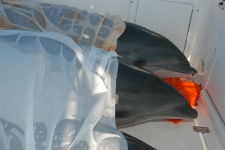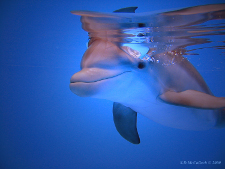- Home
- About Us
- Species
- Research & Data
- Publications & Forms
- Education & Outreach
- For Fishermen/Dealers
- For SEFSC Personnel
Marine Mammal Strandings

Fraser's dolphins, part of a mass stranding of 8 animals in March 2005 in Bookelia, FL
(Lagenodelphis hosei)
Photo Credit: Mote Marine Lab

Orphaned dolphin calf rescued from the Indian River Lagoon, dubbed "RocketMan" because the rescue took place near Cape Canaveral, FL
Photo Credit: Stephen McCulloch, HBOI
Health & Stranding Response
The NMFS Southeast Fisheries Science Center (SEFSC) is the base for the Southeast United States Marine Mammal Stranding Program. NMFS authorizes organizations and volunteers under the Marine Mammal Protection Act (MMPA) to respond to marine mammal strandings throughout the United States. These organizations form the stranding network whose participants are trained to respond to, and collect samples from live and dead marine mammals that strand along southeastern United State beaches. At the SEFSC, we are responsible for
- coordinating stranding events
- monitoring stranding rates
- monitoring human caused mortalities
- maintaining a stranding database for the southeast region
- conducting investigations to determine the cause of unusual stranding events including mass strandings and mass mortalities
Unusual Mortality Events
Pathology
SEFSC staff and members of the Marine Mammal Stranding Network also conduct necropsies on stranded marine mammals in order to determine the
- cause of death
- manner of death
- disease incidence/ health status
NMFS SEFSC has an on-staff marine animal veterinary pathologist for histopathologic analysis of specimens obtained from field necropsies and participation in mortality event investigations.
Contaminants
Marine mammals have been shown to bioaccumulate environmental toxins in various tissues and are considered to be excellent biological indicators within their habitats. The SEFSC provides tissues from stranded marine mammals to be used for contaminant studies in conjunction with:
- National Institute of Standards and Technology (NIST)
- National Ocean Service (NOS)
- National Centers for Coastal Ocean Service (NCCOS)
- Center for Coastal Environmental Health and Biomolecular Research
Genetic Stock analysis
The SEFSC performs research on a wide variety of topics relating to the genetics of marine mammals. We aim to identify genetically unique populations or stocks that may need to be targeted for management priority by using molecular genetic tools such as
- DNA sequencing
- microsatellite analysis
- Amplified Fragment Length Polymorphism (AFLP) markers
Furthermore, we seek to understand the degree of genetic exchange occurring among these different populations of marine mammals.
Species currently of special interest include
- coastal bottlenose dolphins (Tursiops truncatus) in the Atlantic and Gulf of Mexico
- harbor porpoises (Phocoena phocoena) in the Northwest Atlantic
- Atlantic spotted dolphins (Stenella frontalis)
Genetic markers are also used to identify the species of animals that have stranded or been caught in fishing gear when they can not be identified by more traditional methods, e.g., because of tissue degradation. This work allows for accurate accounting of species being negatively impacted by fishing activities. We can also use molecular genetic tools to determine the sex of animals from skin biopsy samples, and thus aid in the interpretation field observations, investigate social and breeding structures, and better understand organo-contaminants data.
Contact: Dr. Patricia Rosel (PI)
How Do I...?
- Distinguish a white marlin from a spearfish
- How do I report a stranded/ beached whale, dolphin, or turtle?
- How do I report a lionfish sighting?
- Access SouthEast Data, Assessment, and Review (SEDAR)
- How do I report for my fishing/dealer permit requirements?
- How do I report a retrieved tag?
- How do I find current fishery closures?
- How do I adopt a billfish?
- How do I register my billfish tournament?
- How do I apply for a permit?
- Visit the SEFSC library
- How do I find NOAA staff?
- How do I apply for grant funding?
- How do I request permission to use a photo found on the website?
- How do I find It? Provide Website Feedback



